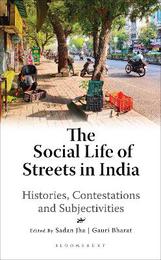
|
The Social Life of Streets in India: Histories, Contestations and Subjectivities
Hardback
Main Details
| Title |
The Social Life of Streets in India: Histories, Contestations and Subjectivities
|
| Authors and Contributors |
Volume editor Sadan Jha
|
|
Volume editor Gauri Bharat
|
| Physical Properties |
| Format:Hardback | | Pages:438 | | Dimensions(mm): Height 216,Width 135 |
|
| Category/Genre | Architecture |
|---|
| ISBN/Barcode |
9789354356858
|
| Audience | | Professional & Vocational | |
|---|
|
Publishing Details |
| Publisher |
Bloomsbury India
|
| Imprint |
Bloomsbury Academic India
|
| Publication Date |
30 December 2022 |
| Publication Country |
India
|
Description
Streets are places that stimulate activities, interactions, behaviours and, by extension, controls. Yet, within the built environment discourse, the street is first and foremost conceptualised as a mute backdrop to movement-vehicular or pedestrian. The Covid-19 pandemic brought renewed focus on the street as the space of networks, flows and mobilities as the 'lockdown' was the preferred mode of controlling the spread of the disease. The Social Life of Streets in India: Histories, Contestations and Subjectivities endeavours to understand the complexities of social dynamics of streets in relation to spatiality and materiality in the Indian milieu. It draws from a diverse body of scholarship and varied disciplinary leanings and engages with three broad strands: historical aspects of streets, the physicality of street as a built environment and social science discourse mediated through anthropology, urban geography, social theory and urban studies. Further the volume deliberates on questions such as: How do we look at streets and, in particular, how do we document and conceptualise streets in the Indian context that highlights the particularities of South Asian milieus? Is the street public? Is it merely a physical space? How does the street in its physicality and in its built form enter or respond to the metaphorical, the literary, the methodological and the social?
Author Biography
Sadan Jha is Associate Professor at Centre for Social Studies, Surat. He is trained in the discipline of history (modern Indian history) and his research interests are in two broad areas: history of visuality and contemporary urban experience. In these fields, he has been working on history of symbols and icons, nation and nationalism, literature, history of colours, contemporary Surat and its transformation in recent decades. Gauri Bharat is Associate Professor and Program Chair of Architectural History and Research at the Faculty of Architecture, CEPT University, Ahmedabad, India. She researches indigenous architecture, politics of place-making in India, and more recently, histories of materials and making.
|